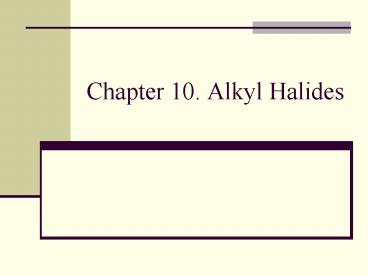Chapter 10' Alkyl Halides - PowerPoint PPT Presentation
1 / 24
Title:
Chapter 10' Alkyl Halides
Description:
An organic compound containing at least one carbon ... C-X bond is longer as you go down periodic table. C-X bond is weaker as you go down periodic table ... – PowerPoint PPT presentation
Number of Views:782
Avg rating:3.0/5.0
Title: Chapter 10' Alkyl Halides
1
Chapter 10. Alkyl Halides
2
What Is an Alkyl Halide
- An organic compound containing at least one
carbon-halogen bond (C-X) - X (F, Cl, Br, I) replaces H
- Can contain many C-X bonds
- Properties and some uses
- Fire-resistant solvents
- Refrigerants
- Pharmaceuticals and precursors
3
10.1 Naming Alkyl Halides
- Name is based on longest carbon chain
- (Contains double or triple bond if present)
- Number from end nearest any substituent (alkyl or
halogen)
4
Naming with Multiple Halides
- If more than one of the same kind of halogen is
present, use prefix di, tri, tetra - If there are several different halogens, number
them and list them in alphabetical order
5
Naming if Two Halides or Alkyl Are Equally
Distant from Ends of Chain
- Begin at the end nearer the substituent whose
name comes first in the alphabet
6
Many Alkyl Halides That Are Widely Used Have
Common Names
- Chloroform
- Carbon tetrachloride
- Methylene chloride
- Methyl iodide
- Trichloroethylene
7
10.2 Structure of Alkyl Halides
- C-X bond is longer as you go down periodic table
- C-X bond is weaker as you go down periodic table
- C-X bond is polarized with slight positive on
carbon and slight negative on halogen
8
10.3 Preparing Alkyl Halides
- Alkyl halide is from addition of HCl, HBr, HI to
alkenes to give Markovnikov product (see Alkenes
chapter) - Alkyl dihalide from anti addition of bromine or
chlorine
9
Reaction of Alkanes with Halogens
- Alkane Cl2 or Br2, heat or light replaces C-H
with C-X but Gives mixtures - Hard to control
- Via free radical mechanism
- See mechanism in Figure 1-1
- It is usually not a good idea to plan a synthesis
that uses this method
10
10.4 Radical Halogenation of Alkanes
- If there is more than one type of hydrogen in an
alkane, reactions favor replacing the hydrogen at
the most highly substituted carbons (not absolute)
11
Relative Reactivity
- Based on quantitative analysis of reaction
products, relative reactivity is estimated - Order parallels stability of radicals
- Reaction distinction is more selective with
bromine than chlorine (See Figure 10-2)
12
10.5 Allylic Bromination of Alkenes
- N-bromosuccinimide (NBS) selectively brominates
allylic positions - Requires light for activation
- A source of dilute bromine atoms
13
Allylic Stabilization
- Allyl radical is delocalized
- More stable than typical alkyl radical by 40
kJ/mol (9 kcal/mol - Allylic radical is more stable than tertiary
alkyl radical
14
10.6 Stability of the Allyl Radical Resonance
Revisited
- Three electrons are delocalized over three
carbons - Spin density surface shows single electron is
dispersed
15
Use of Allylic Bromination
- Allylic bromination with NBS creates an allylic
bromide - Reaction of an allylic bromide with base produces
a conjugated diene, useful in synthesis of
complex molecules
16
10.7 Preparing Alkyl Halides from Alcohols
- Reaction of tertiary C-OH with HX is fast and
effective - Add HCl or HBr gas into ether solution of
tertiary alcohol - Primary and secondary alcohols react very slowly
and often rearrange, so alternative methods are
used
17
Preparation of Alkyl Halides from Primary and
Secondary Alcohols
- Specific reagents avoid acid and rearrangements
of carbon skeleton - Thionyl chloride converts alcohols into alkyl
chlorides (SOCl2 ROH ? RCl) - Phosphorus tribromide converts alcohols into
alkyl bromides (PBr3 ROH ? RBr)
18
10.8 Reactions of Alkyl Halides Grignard Reagents
- Reaction of RX with Mg in ether or THF
- Product is RMgX an organometallic compound
(alkyl-metal bond) - R is alkyl 1, 2, 3, aryl, alkenyl
- X Cl, Br, I
19
Reactions of Grignard Reagents
- Many useful reactions
- RMgX behaves as R- (adds to CO)
- RMgX H3O ? R-H
20
10.9 Organometallic Coupling Reactions
- Alkyllithium (RLi) forms from RBr and Li metal
- RLi reacts with copper iodide to give lithium
dialkylcopper (Gilman reagents) - Lithium dialkylcopper reagents react with alkyl
halides to give alkanes
21
Utility of Organometallic Coupling in Synthesis
- Coupling of two organometallic molecules produces
larger molecules of defined structure - Aryl and vinyl organometallics also effective
- Coupling of lithium dialkylcopper molecules
proceeds through trialkylcopper intermediate
22
10.10 Oxidation and Reduction in Organic Chemistry
- In organic chemistry, we say that oxidation
occurs when a carbon or hydrogen that is
connected to a carbon atom in a structure is
replaced by oxygen, nitrogen, or halogen - Not defined as loss of electrons by an atom as in
inorganic chemistry - Oxidation is a reaction that results in loss of
electron density at carbon (as more
electronegative atoms replace hydrogen or carbon)
Oxidation break C-H (or C-C) and form C-O, C-N,
C-X
23
Reduction Reactions
- Organic reduction is the opposite of oxidation
- Results in gain of electron density at carbon
(replacement of electronegative atoms by hydrogen
or carbon)
Reduction form C-H (or C-C) and break C-O, C-N,
C-X
24
Oxidation Levels
- Functional groups are associated with specific
levels































